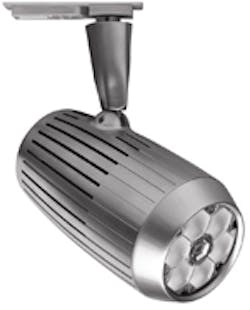With 23 interconnected buildings combined to equal more than 1.2 million square feet, keeping exhibits at the American Museum of Natural History well lit can certainly be a challenging task. Just ask David Clinard, lighting designer for the New York museum.
“In the typical 8,000-square-foot temporary exhibition space, we use about 200 to 300 fixtures,” says Clinard, noting that with halogen sources these bulbs frequently have to be changed.
Hoping to find a cure for this ongoing problem, Clinard recently beta tested a new LED luminaire called LumeLEX, manufactured by the Stony Point, N.Y.-based high-end display lighting company Lighting Services. Turns out the product produced the results Clinard was looking for, decreasing the amount of time and money he had to spend on changing burnt-out bulbs and providing high-quality white light for the museum's world-renowned exhibits.
“Basically the LumeLEX LEDs just go and go until you have to replace the whole unit,” he says. “There's energy savings because it uses only about a quarter to a third of the amount of energy that's required for a halogen source.”
According to its maker, the lifespan of the product is rated at 50,000 hours, “which in normal exhibit usage would be somewhere in the neighborhood of 12 to 14 years,” says Ken Kane, vice president of product and market development for Lighting Services. This lengthy lifespan is largely due to low energy consumption.
Clinard says another advantage of the LumeLEX over other exhibit lighting fixtures he's used in the past is that the color of this white LED light can be adjusted from a warm tone to a cool tone with the turn of a knob or the push of a button. “To me, that's one of the great benefits of this fixture,” he says, noting that the alternative would require adding color filters to the fixture.
“The intensity of the light is comparable to approximately a 75W halogen PAR lamp, and it's being done for approximately 35W of system power,” Kane explains. “So it's essentially delivering the same quality and intensity of light for half of the power consumption.”
Introduced earlier this month at LightFair International in Las Vegas, LumeLEX is the first commercially available luminaire to use Vancouver-based research and development firm TIR Systems' Lexel lighting technology. Kane says Lexel was the first technology he found that provided good quality, usable white light using an LED.
“Most of the LED products that we've seen out there over the years have been terrific at doing certain things — great for delivering colored light and changeable colored light,” Kane says. “And although there have been attempts specifically with white lighting LEDs, we always felt those fell a little bit short of the mark in terms of what our customers would demand.”
So what set TIR's Lexel technology apart from the competition? First, Kane says, its thermal management was much more advanced than other products he'd seen. Heat can be extremely detrimental to the quality of LED light, but instead of just attaching a secondary heat sink made out of aluminum, Kane says Lexel uses a proprietary method of heat extraction integrated into the technology at the chip level.
Another way Lexel technology controls the quality of its white light is through constant performance feedback, making minute changes in real time as needed with the use of a microcontroller. “Consistency of intensity and consistency of the color are done not through calculations and guesswork, but they're actually done through on-board monitoring and feed-back loop systems,” Kane says.
For example, the LumeLEX's white light is created using a mix of red, green, and blue LEDs, but if the red degrades more quickly than the other colors, the system would take notice and ramp up the power to the red in order to compensate and achieve the proper mix pre-set by the user.
The final design consideration that Kane says sets Lexel apart from other white light LED technologies is its optical control. Using a primary and secondary lens and a 16-degree beam spread, he says the technology creates a clean even light, free of fringing and color striations often associated with other LED systems.
But in order to fully take advantage of the Lexel technology, Kane says Lighting Services' design of the physical fixture was also extremely important. “The fixture design had to incorporate proper thermal management, so that we get the life out of it,” he says. “It's one thing to build in thermal management into the core technology, but if the actual fixture design doesn't allow for that, you haven't really helped it.”
In order to make what Kane calls a “plug-and-play” fixture, the design team also built control switches for the color temperature and intensity control — which can change the intensity from 100% down to 10% — directly into the luminaire. “The primary reason for doing that was to make it very simple to operate, very simple to understand, and you don't have to completely redo an infrastructure with communication devices in order to integrate this new technology,” he says.
The LumeLEX is expected to hit the consumer market at the end of 2006. While the price for this fixture has not yet been set, Kane says he expects it will be “marginally higher than the price of a sophisticated low-wattage metal-halide product.”
For more information, visit www.LightingServicesInc.com.
